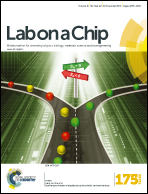Multiplex cell microarrays for high-throughput screening
Abstract
Microarray technology was developed in the early 1990s to measure the transcription levels of thousands of genes in parallel. The basic premise of high-density arraying has since been expanded to create cell microarrays. Cells on chip are powerful experimental tools for high-throughput and multiplex screening of samples or cellular functions. Miniaturization increases assay throughput while reducing both reagent consumption and cell population heterogeneity effect, making these systems attractive for a wide range of assays, from drug discovery to toxicology, stem cell research and therapy. It is usual to functionalize the surface of a substrate to design cell microarrays. One form of cell microarrays, the transfected cell microarray, wherein plasmid DNA or siRNA spotted on the surface of a substrate is reverse-transfected locally into adherent cells, has become a standard tool for parallel cell-based analysis. With the advent of technology, cells can also be directly spotted onto functionalized surfaces using robotic fluid-dispensing devices or printed directly on bio-ink material. We are providing herein an overview of the latest developments in optical cell microarrays allowing high-throughput and high-content analysis.


 Please wait while we load your content...
Please wait while we load your content...